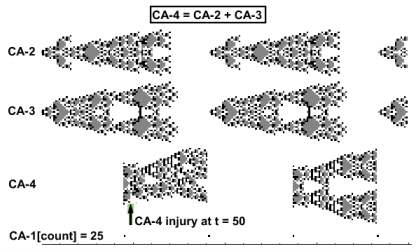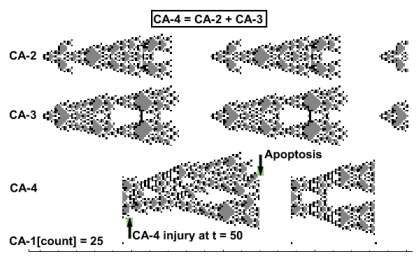 |
Apoptosis
A previous experiment, depicted the effect of CA-2 injury on system health. Here we study the effect of CA-4 injury on the system itself. At t =50, a border CA-4 cell was set to zero (white), Process structure changed, and when CA-1[count] = 25 it was killed.
 |
CA-4 = CA-2 + CA-3, is best regarded as an option, and not as an equation, since its execution depends on system context. .On one hand it creates a CA-4, while on the other, it kills it. The second option eliminated also the injured CA-4. Yet when failing, the injured process continues growing chaotically, like in the next experiment in which CA-1 failed to kill the injured CA-4.
 |
In order to protect itself, stem process kills any process which survives longer than a
given time, This mechanism is called apoptosis. It guarantees that all processes in a system are solutions. If left alone
a perturbed process assumes four kinds of behavior:
1. Does not change
2. Becomes a different solution.
3. Becomes a non-solution (chaotic).
4. Dies
Apoptosis eliminates non-solutions.
If killing a damaged process too
soon, it may eliminate a solution with a longer period.. On the other
hand, a prolonged non-solution threatens to wipe the system out.
A zygote is planted, and becomes a stem process, which
plants stem cells of transient processes, and controls them. Ultimately
the proliferon finds its solution, called Homeorhesis, and maintains it
until an injury has changed it.